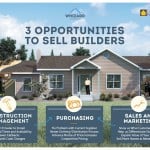One of the first questions, a builder asks is “How much more does it cost?” The big box buyer frequently says, “Your price is too high.” There are two solutions to the problem of prices that are viewed as too high.
The best way to handle a building product price objection is to change the context.
Most customers look at how much more your product costs than what they currently use. You need to change the comparison.
Here’s an example. I once had a client that made composite siding products. Despite the enhanced appearance and performance benefits of the siding, they were struggling to grow their sales. Composite siding looks very much like expensive materials like wood cedar shake, brick, and stone.
We looked into their sales process and found that they were selling up from vinyl siding. The first part of the discussion was always about how much more they cost than vinyl.
We developed a graph that showed the costs of all exterior materials including vinyl, fiber cement, composite, brick, stone, wood and more. When the customer looked at it in this context, he saw how composite siding was lower in cost compared to the materials it was designed to replace. The result was this manufacturer’s sales went up as the discussion no longer started at the bottom with vinyl. Here is an example graph from Siding Magazine.
The other way to handle a building product price objection is to simply change the discussion.
To help a customer understand a product, salespeople will frequently start by comparing their product to an existing product. Their product almost always costs more.
A better way to approach this is to avoid comparing it to anything that exists. Think of your product as a revolutionary new solution that doesn’t compare to anything on the market.
You can do this by staying focused on the problem the product solves for the customer. For example, if you were describing airplane travel to a stagecoach company in the late 1800’s you wouldn’t start by discussing how much more air travel costs. Airplane travel has nothing to do with a stagecoach. Ideally, you want to act like you would if you were introducing airplanes to someone who’s never heard of them.
Most sales people undervalue their products. They see them as the same as something that exists, only a little better and more expensive.
If I were marketing air travel in the late 1800’s, I would start by talking about the problems with travel as it existed.
- It takes a long time to get to your destination.
- It’s dusty and uncomfortable.
- And don’t forget the danger of bandits.
I would then talk about those problems disappearing and only then introduce air travel. It starts with believing that you truly have a better solution and developing a story that focuses on the problems it solves versus the price. It doesn’t start with the price or describing an airplane. You also need to believe that your product really is an improvement and not just a minor upgrade.
When you allow the discussion to start with pricing, it’s like you just jumped in a hole and have to claw your way back up. Why not start and stay on top? The selling is much easier when you’re looking the customer in the eye instead of looking up at him.
Subscribe To My Newsletter
If you like what I say, sign up for my newsletter here and get my weekly newsletter every Sunday night.
Thanks for the following comments. I’d like to hear your feedback and suggestions on how to sell architects.
“Completely agreee. Back in the 70’s, Ford would compare their Granada model to a Mercedes. Mercedes NEVER compared their product to Ford. Why would they? Find the problem, then sell the solution.”
John Zito
Business Development and Consultant
LEAP Adviser
“Software built for window and door people by window and door people
100% agree. Focus on and highlight your 10x factor.”
Jeff Olson
National Sales Manager
PATH / ERP
“Great atricle Mark Mitchell”
Andy Solomon
Director of Sales Training
Associated Materials












